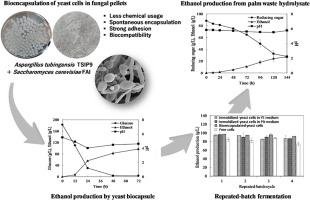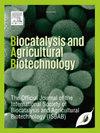Optimizing bioencapsulation of yeast cells by Aspergillus tubingensis TSIP9 and applications in bioethanol production through repeated-batch fermentation
IF 3.4
Q2 BIOTECHNOLOGY & APPLIED MICROBIOLOGY
引用次数: 0
Abstract
This study aimed to immobilize yeast cells using filamentous fungi owing to a number of advantages including less chemical usage, spontaneous encapsulation, strong adhesion and biocompatibility. Filamentous fungus, Aspergillus tubingensis TSIP9 could form sphere-shape and packed pellets using either fungal fresh spores or those stored in liquid medium for 6 weeks at 4 °C. The fungus was used to immobilize yeast Saccharomyces cerevisiae FAI via adsorption and co-cultivation methods. Scanning electron microscopy images revealed that the bioencapsulated yeast cells via co-cultivation seemed to be more tightly adhered on fungal mycelia and surrounded by extracellular polymeric substances. The yeast biocapsules also exhibited higher stability and maintained their structural integrity during repeated-batch fermentation while the immobilized yeast cells by adsorption gradually degraded during their repeated uses. The bioethanol production from glucose by yeast biocapsules were in the range of 95–98 g/L with the bioethanol yield of 0.49–0.54 g-ethanol/g-consumed glucose. The yeast biocapsules could produce bioethanol well when using enzymatic hydrolysate of lignocellulosic palm waste, as alternative cheap carbon source, with the comparable bioethanol yield of 0.49 ± 0.17 g-ethanol/g-consumed glucose. The spontaneous and inter-species bioencapsulation show the perspectives as active biocatalysts with high cell retention for repeated uses.

优化管曲霉 TSIP9 对酵母细胞的生物包裹以及在通过重复批量发酵生产生物乙醇中的应用
本研究旨在利用丝状真菌固定酵母细胞,因为丝状真菌具有化学用量少、自发封装、附着力强和生物相容性好等优点。丝状真菌管曲霉 TSIP9 可以形成球形和包装颗粒,使用的真菌孢子可以是新鲜的,也可以是在液体培养基中 4 ℃ 下储存 6 周的孢子。该真菌可通过吸附和共培养方法固定酿酒酵母(Saccharomyces cerevisiae FAI)。扫描电子显微镜图像显示,通过共培养获得的生物胶囊酵母细胞似乎更紧密地附着在真菌菌丝体上,并被细胞外高分子物质包围。酵母生物胶囊还表现出更高的稳定性,在重复批次发酵过程中保持结构完整性,而吸附固定的酵母细胞在重复使用过程中逐渐降解。酵母生物胶囊利用葡萄糖生产生物乙醇的产量在 95-98 克/升之间,生物乙醇产量为 0.49-0.54 克乙醇/克消耗葡萄糖。当使用木质纤维素棕榈废料的酶水解物作为替代性廉价碳源时,酵母生物胶囊能很好地生产生物乙醇,生物乙醇产量为 0.49 ± 0.17 g-乙醇/g-消耗的葡萄糖。自发和种间生物封装表明,这种生物催化剂具有活性,细胞保留率高,可重复使用。
本文章由计算机程序翻译,如有差异,请以英文原文为准。
求助全文
约1分钟内获得全文
求助全文
来源期刊

Biocatalysis and agricultural biotechnology
Agricultural and Biological Sciences-Agronomy and Crop Science
CiteScore
7.70
自引率
2.50%
发文量
308
审稿时长
48 days
期刊介绍:
Biocatalysis and Agricultural Biotechnology is the official journal of the International Society of Biocatalysis and Agricultural Biotechnology (ISBAB). The journal publishes high quality articles especially in the science and technology of biocatalysis, bioprocesses, agricultural biotechnology, biomedical biotechnology, and, if appropriate, from other related areas of biotechnology. The journal will publish peer-reviewed basic and applied research papers, authoritative reviews, and feature articles. The scope of the journal encompasses the research, industrial, and commercial aspects of biotechnology, including the areas of: biocatalysis; bioprocesses; food and agriculture; genetic engineering; molecular biology; healthcare and pharmaceuticals; biofuels; genomics; nanotechnology; environment and biodiversity; and bioremediation.
 求助内容:
求助内容: 应助结果提醒方式:
应助结果提醒方式:


